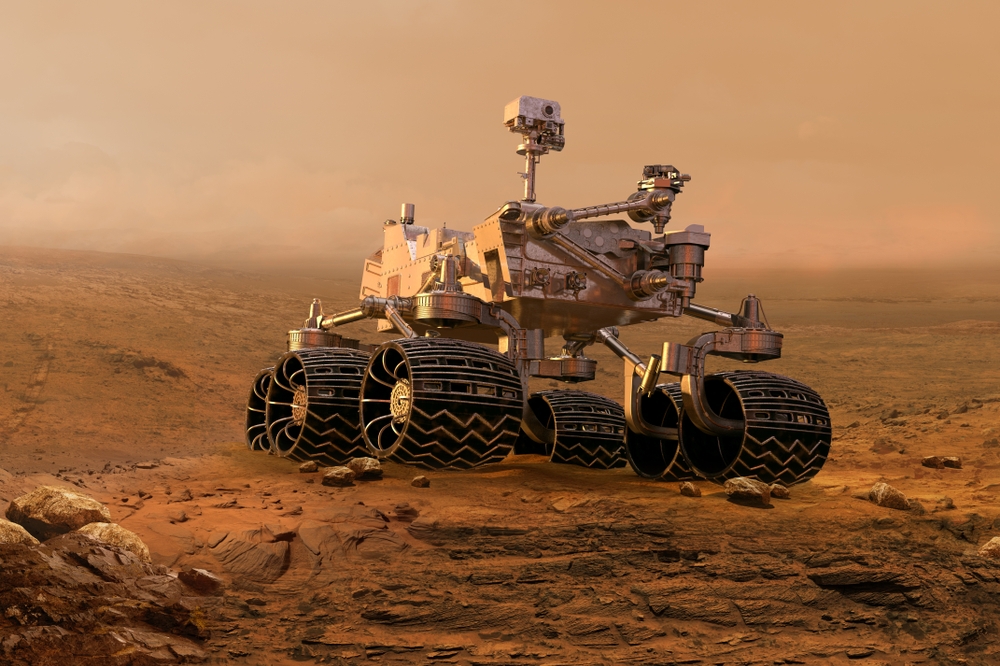SiC UV diodes key component in Mars mission

SiC photodiodes central to the search for past water impact and signs of past life on Mars
A SiC UV photodiode from the Berlin-based company Sglux has travelled on board the current NASA mission Mars 2020.
The SiC chip with the heterostructures for the UV photodiode was processed at Fraunhofer IISB in Erlangen on the institute's own CMOS line. Since the Mars rover 'Perseverance' landed on the surface of Mars on February 18, 2021, the SiC photodiode has been functioning with absolute reliability under extreme environmental conditions.
The UV sensor is a component of the SHERLOC deep-UV Raman spectrometer, employed by NASA to search for traces of past life on the surface of Mars. Fraunhofer IISB offers SMEs, mid-sized companies and industry low-threshold access to high-tech infrastructure and unique know-how in the field of semiconductor technology.
Life on Mars
Perseverance has a suite of state-of-the-art science instruments, among which a deep-UV Raman spectrometer attached to the rover's robotic arm plays a special role. Dubbed SHERLOC (Scanning Habitable Environments with Raman & Luminescence for Organics & Chemicals), the high-tech instrument is the first ever UV Raman spectrometer on Mars. There, it enables non-contact, spatially resolved and highly sensitive detection and characterisation of organic matter and minerals on the surface and in the near subsurface.
Supported by a special camera called WATSON (Wide Angle Topographic Sensor for Operations and eNgineering) and a UV LASER, SHERLOC detects organic matter and minerals and creates topographic maps from them. Researchers on Earth then evaluate the measurement results and mineralogical maps to see if there is evidence of past water impact and signs of past life on Mars. Based on this, it will be decided which rock samples Perseverance should take and leave sealed in metal tubes on the surface of Mars for a future return to Earth (resample mission).
Ultimate Endurance Test
For its measurements, the UV Raman spectrometer uses a deep UV laser with a wavelength of 248.6 nm focused on a spot less than 100 µm in diameter. A SG01XL-5 SiC UV broadband photodiode from Sglux is installed near the laser aperture, and detects the UV radiation power emitted by SHERLOC during spectral map measurements so that the laser output can be monitored when scanning the surface.
Before its use, Sglux adapted the manufacturing process of this photodiode to its application and carried out elaborate selection, testing and characterisation procedures. Subsequently, NASA subjected the candidates selected in this way to further tests and trials, for example on vibration resistance, behaviour under strong acceleration, high-temperature resistance and alternating strength.
Material Properties
Due to its properties, SiC is well suited for daylight-insensitive UV detectors and difficult environments. The SiC-based photodiodes are almost completely blind to light in the visible wave range and impress with their high response speed. The small dark current in the femtoampere range ensures low noise, so that even very low UV radiation intensities can be measured reliably.
The SiC detectors tolerate comparatively high operating temperatures and operate stable in a temperature range from minus 55 to plus 170 °C. In this case, the temperature coefficient of the signal reaches values of less than 0.1 % per Kelvin and temperature-related changes in the measurement sensitivity can be compensated well. In addition, SiC has extreme radiation hardness, allowing the devices to retain their excellent electrical properties even when exposed to long and strong irradiation.
Tilman Weiss, managing director of Sglux GmbH commented: "Our claim is that our UV sensors always last longer than the system in which they are installed. The mission to Mars so far is great confirmation of this fact, and also of our collaboration with Fraunhofer IISB. For the core of our products, we need precisely the technological expertise and system infrastructure available at the IISB. Only the symbiosis of entrepreneurship and research enables us to create sustainable value with exclusive products that are in demand worldwide."
Oleg Rusch, group manager SiC bipolar devices at Fraunhofer IISB, gives the following assessment: "Pure semiconductor manufacturing is not actually primary for the IISB, even though the processing of prototypes, special components and very small series is now part of our daily business. Our overall primary concern is to provide scientific excellence, process know-how and outstanding facility infrastructure to SMEs and industry. We see untapped potential for innovation at many companies that could be opened up with scientific support and R&D services in semiconductors."


































